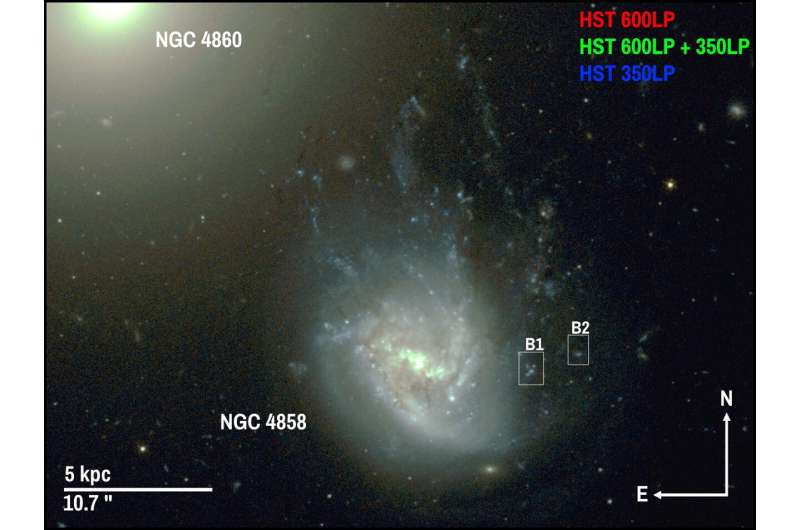Astronomers have discovered a “jellyfish” galaxy whose unusual shape and internal mechanisms—including distinctive “bunny ears” and an inner “tail”—are giving researchers an unprecedented view of dynamics within one of the universe’s most extreme environments.
For a new study, a team led by Yale astronomers Harrison Souchereau and Jeffrey Kenney focused on the internal and external forces influencing a galaxy known as NGC 4858, located in the Coma cluster, more than 300 million light-years from Earth.
Galaxy clusters are some of the largest structures in the universe, containing massive amounts of hot gas, dark matter, and hundreds—even thousands—of galaxies. As an individual galaxy moves through a cluster, extreme outside pressure (called ram pressure or “wind”) strips away a portion of the galaxy’s interior gas. This narrows and elongates the galaxy, giving it a “jellyfish” appearance right down to the long trails of gas and young stars that resemble jellyfish tendrils.
“This galaxy, NGC 4858, is traveling very quickly through the Coma cluster,” said Souchereau, a doctoral student in Yale’s Graduate School of Arts and Sciences and first author of the new study. “It is effectively in a wind tunnel, and its gas is in the process of being stripped away by the wind.”
For the study, Souchereau and senior author Kenney, a professor of astronomy in Yale’s Faculty of Arts and Sciences, obtained high-resolution images of the molecular gas in NGC 4858 from an ALMA radio telescope survey of jellyfish galaxies.

Not only were the researchers able to discern the galaxy’s jellyfish-like shape, they also found some other intriguing new features.
For example, the strong ram pressure created distorted spiral arm features within the galaxy that look like bunny ears, Souchereau said. “This is likely due to a combination of the environmental wind pushing on the gas, and the rotation of the galaxy,” he said.
The researchers also found evidence of a phenomenon known as “fallback,” in which gas has been pushed out of the galaxy disk but then falls back toward the disk. Although other researchers have observed fallback previously, Souchereau said, it has never been seen so clearly and unambiguously as in the new study.
“Most people think of ram pressure stripping as removing the gas from galaxies, which is the main effect and a big deal, since gas is the raw material for star formation,” Kenney said. “But sometimes gas can get pushed out but not stripped, since it never reaches the escape speed. So it falls back, creating a kind of galactic fountain. When this happens, the gas falling back often concentrates in distorted spiral arms on one side of the inner tail.”
Souchereau presented the findings at a press briefing at the American Astronomical Society’s summer meeting. The paper is available on the arXiv preprint server.
Co-authors of the study included researchers from the Czech Republic, Japan, France, the United Kingdom, Australia, Estonia, Italy, China, Portugal, and the United States.
In addition to the data from ALMA, the researchers used data from the Subaru Telescope operated by the National Astronomical Observatory of Japan; data based on observations made with the NASA/ESA Hubble Space Telescope; and data obtained from the Hubble Legacy Archive.
More information:
Harrison J. Souchereau et al, ALMA-JELLY I: High Resolution CO(2-1) Observations of Ongoing Ram Pressure Stripping in NGC 4858 Reveal Asymmetrical Gas Tail Formation and Fallback, arXiv (2025). DOI: 10.48550/arxiv.2506.07262
Citation:
Astronomers map unusual inner workings of a jellyfish galaxy with ‘bunny ears’ (2025, June 12)
retrieved 12 June 2025
from https://phys.org/news/2025-06-astronomers-unusual-jellyfish-galaxy-bunny.html
This document is subject to copyright. Apart from any fair dealing for the purpose of private study or research, no
part may be reproduced without the written permission. The content is provided for information purposes only.

